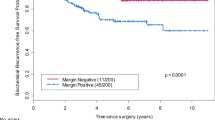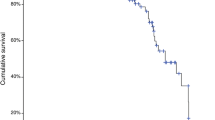Abstract
Purpose
The tumor volume or extent measurement in radical prostatectomy (RP) specimens is time-consuming and technically difficult. We aimed at studying the independent prognostic value of tumor extent for biochemical progression-free following RP once it is controversial.
Methods
This retrospective study was based on 305 consecutive patients submitted to RP. In whole-mount and totally embedded surgical specimens, tumor extent was evaluated with a point-count semi-quantitative method and correlated to several clinical and pathological variables. Biochemical progression was defined as PSA ≥ 0.2 ng/ml; time to progression-free outcome was studied using the Kaplan–Meier product-limit analysis and univariate and multivariate analyses using the Cox stepwise logistic regression.
Results
More extensive tumors showed significantly higher preoperative PSA (P < 0.01), higher clinical stage (P = 0.03), higher positive surgical margins (P < 0.01), higher pathological stage (P < 0.01), and higher Gleason score on needle biopsies (P < 0.01) and on surgical specimens (P < 0.01). On univariate analysis, biochemical progression correlated with tumor extension (P < 0.01), preoperative PSA (P < 0.01), Gleason score on needle biopsies (P = 0.02) and on surgical specimens (P < 0.01), positive surgical margins (P = 0.01), and pathological stage (P = 0.01). There was no difference related to time of biochemical recurrence comparing less extensive with more extensive tumors (P = 0.20). In multivariate analysis, tumor extent was not predictive of biochemical progression combined to any one of the variables studied (P > 0.05).
Conclusions
Tumor extent did not provide in our study additional predictive information for biochemical progression following RP beyond preoperative PSA, Gleason score, positive surgical margins, and pathological stage.

Similar content being viewed by others
References
Humphrey PA, Vollmer RT (1990) Intraglandular tumor extent and prognosis in prostatic carcinoma: Application of a grid method to prostatectomy specimens. Hum Pathol 21:799–804
Stamey TA, McNeal JE, Yemoto CM, Sigal BM, Johnstone IM (1999) Biological determinants of cancer progression in men with prostate cancer. JAMA 281:1395–1400
Carvalhal GF, Humphrey PA, Thorson P, Yan Y, Ramos CG, Catalona WJ (2000) Visual estimate of the percentage of carcinoma is an independent predictor of prostate carcinoma recurrence after radical prostatectomy. Cancer 89:1308–1314
Humphrey P, Vollmer RT (1988) The ratio of prostate chips with cancer: A new measure of tumor extent and its relationship to grade and prognosis. Hum Pathol 19:411–418
McNeal JE, Bostwick DG, Kindrachuk RA, Redwine EA, Freiha FS, Stamey TA (1986) Patterns of progression in prostate cancer. Lancet 1:60–63
Epstein JI, Oesterling JE, Walsh PC (1988) Tumor volume versus percentage of specimen involved by tumor correlated with progression in stage A prostatic carcinoma. J Urol 139:980–984
Partin AW, Epstein JI, Cho KR, Gittelsohn AM, Walsh PC (1989) Morphometric measurement of tumor volume and per cent of gland involvement as predictors of pathological stage in clinical stage B prostate cancer. J Urol 141:341–345
McNeal JE, Price HM, Redwine EA, Freiha FS, Stamey TA (1988) Stage A versus stage B adenocarcinoma of the prostate: Morphological comparison and biological significance. J Urol 139:61–65
Epstein JI, Carmichael M, Partin AW, Walsh PC (1993) Is tumor volume an independent predictor of progression following radical prostatectomy? A multivariate analysis of 185 clinical stage B adenocarcinomas of the prostate with 5 years of followup. J Urol 149:1478–1481
Salomon L, Levrel O, Anastasiadis AG, Irani J, De La Taille A, Saint F et al (2003) Prognostic significance of tumor volume after radical prostatectomy: A multivariate analysis of pathological prognostic factors. Eur Urol 43:39–44
Billis A, Magna LA, Ferreira U (2003) Correlation between tumor extent in radical prostatectomies and preoperative PSA, histological grade, surgical margins, and extraprostatic extension: Application of a new practical method for tumor extent evaluation. Int Braz J Urol 29:113–119
Cantrell BB, DeKlerk DP, Eggleston JC, Boitnott JK, Walsh PC (1981) Pathologic factors that influence prognosis in stage A prostatic cancer: The influence of extent versus grade. J Urol 125:516–520
Humphrey PA, Vollmer RT (1997) Percentage carcinoma as a measure of prostatic tumor size in radical prostatectomy tissues. Mod Pathol 10:326–333
Renshaw AA, Chang H, DÁmico AV (1997) Estimation of tumor volume in radical prostatectomy specimens in routine clinical practice. Am J Clin Pathol 107:704–708
Renshaw AA, Richie JR, Loughlin KR, Jiroutek M, Chung A, D’Amico AV (1999) Maximum diameter of prostatic carcinoma is a simple, inexpensive, and independent predictor of prostate-specific antigen failure in radical prostatectomy specimens. Am J Clin Pathol 111:641–644
Bostwick DG, Montironi R (1997) Evaluating radical prostatectomy specimens: Therapeutic and prognostic importance. Virchows Arch 430:1–16
Epstein JI, Carmichael M, Walsh PC (1993) Adenocarcinoma of the prostate invading the seminal vesicle: Definition and relation of tumor volume, grade and margins of resection to prognosis. J Urol 149:1040–1045
Billis A, Freitas LLL, Magna LA, Samara AB, Ferreira U (2004) Prostate cancer with bladder neck involvement: Pathologic findings with application of a new practical method for tumor extent evaluation and recurrence-free survival after radical prostatectomy. Int Urol Nephrol 36:363–368
Gleason DF, Mellinger GT, The Veterans Administration Cooperative Urological Research Group (1974) Prediction of prognosis for prostatic adenocarcinoma by combined histological grading and clinical staging. J Urol 111:58–64
Gleason DF (1977) Histologic grading and clinical staging of prostatic carcinoma. In: Tannenbaum M (ed) Urologic pathology. The prostate. Lea & Febiger, Philadelphia, pp 171–198
Cookson MS, Aus G, Burnett AL, Canby-Hagino ED, D’Amico AV, Dmochowski RR et al (2007) Variation in the definition of biochemical recurrence in patients treated for localized prostate cancer: The American Urological Association prostate guidelines for localized prostate cancer update panel report and recommendations for a standard in the reporting of surgical outcomes. J Urol 177:540–545
Rampersaud EN, Sun L, Moul JW, Madden J, Freedland SJ (2008) Percent tumor involvement and risk of biochemical progression after radical prostatectomy. J Urol 180:571–576
Wolters T, Roobol MJ, van Leeuwen PJ et al (2009) Should pathologists routinely report prostate tumour volume? The prognostic value of tumour volume in prostate cancer. Eur Urol. doi:10.1016/j.eururo.2009.07.027
Author information
Authors and Affiliations
Corresponding author
Rights and permissions
About this article
Cite this article
Billis, A., Meirelles, L., Freitas, L.L. et al. Tumor extent in radical prostatectomy specimens: is it an independent prognostic factor for biochemical (PSA) progression following surgery?. Int Urol Nephrol 43, 417–422 (2011). https://doi.org/10.1007/s11255-010-9818-4
Received:
Accepted:
Published:
Issue Date:
DOI: https://doi.org/10.1007/s11255-010-9818-4




